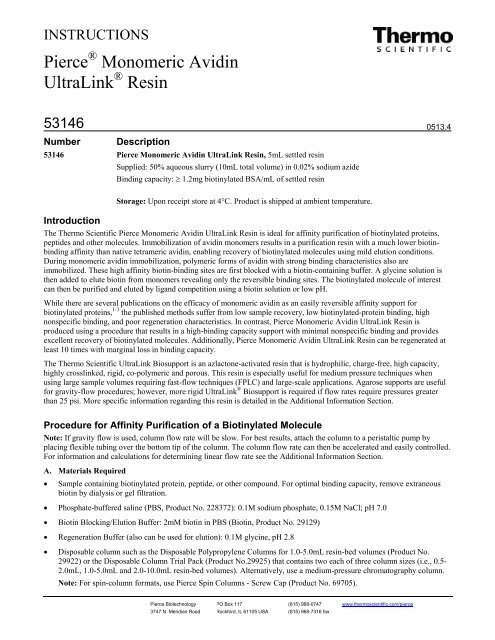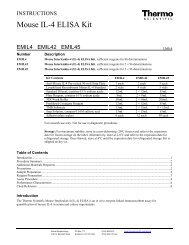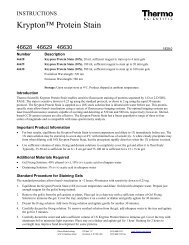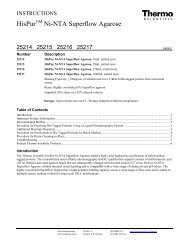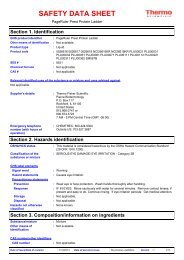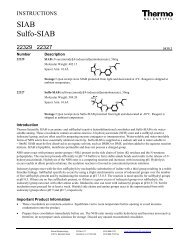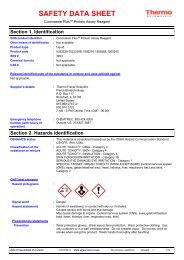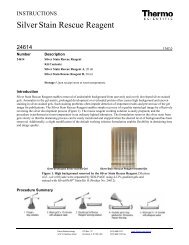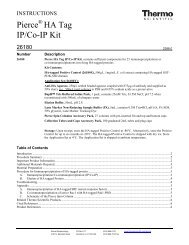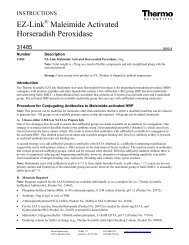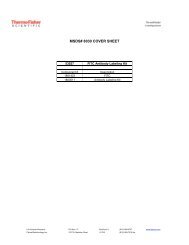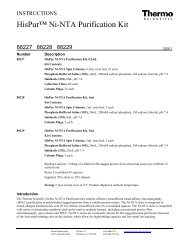Pierce® Monomeric Avidin UltraLink® Resin
Pierce® Monomeric Avidin UltraLink® Resin
Pierce® Monomeric Avidin UltraLink® Resin
You also want an ePaper? Increase the reach of your titles
YUMPU automatically turns print PDFs into web optimized ePapers that Google loves.
INSTRUCTIONS<br />
Pierce ® <strong>Monomeric</strong> <strong>Avidin</strong><br />
UltraLink ® <strong>Resin</strong><br />
53146<br />
Number Description<br />
53146 Pierce <strong>Monomeric</strong> <strong>Avidin</strong> UltraLink <strong>Resin</strong>, 5mL settled resin<br />
Supplied: 50% aqueous slurry (10mL total volume) in 0.02% sodium azide<br />
Binding capacity: ≥ 1.2mg biotinylated BSA/mL of settled resin<br />
0513.4<br />
Storage: Upon receipt store at 4°C. Product is shipped at ambient temperature.<br />
Introduction<br />
The Thermo Scientific Pierce <strong>Monomeric</strong> <strong>Avidin</strong> UltraLink <strong>Resin</strong> is ideal for affinity purification of biotinylated proteins,<br />
peptides and other molecules. Immobilization of avidin monomers results in a purification resin with a much lower biotinbinding<br />
affinity than native tetrameric avidin, enabling recovery of biotinylated molecules using mild elution conditions.<br />
During monomeric avidin immobilization, polymeric forms of avidin with strong binding characteristics also are<br />
immobilized. These high affinity biotin-binding sites are first blocked with a biotin-containing buffer. A glycine solution is<br />
then added to elute biotin from monomers revealing only the reversible binding sites. The biotinylated molecule of interest<br />
can then be purified and eluted by ligand competition using a biotin solution or low pH.<br />
While there are several publications on the efficacy of monomeric avidin as an easily reversible affinity support for<br />
biotinylated proteins, 1-3 the published methods suffer from low sample recovery, low biotinylated-protein binding, high<br />
nonspecific binding, and poor regeneration characteristics. In contrast, Pierce <strong>Monomeric</strong> <strong>Avidin</strong> UltraLink <strong>Resin</strong> is<br />
produced using a procedure that results in a high-binding capacity support with minimal nonspecific binding and provides<br />
excellent recovery of biotinylated molecules. Additionally, Pierce <strong>Monomeric</strong> <strong>Avidin</strong> UltraLink <strong>Resin</strong> can be regenerated at<br />
least 10 times with marginal loss in binding capacity.<br />
The Thermo Scientific UltraLink Biosupport is an azlactone-activated resin that is hydrophilic, charge-free, high capacity,<br />
highly crosslinked, rigid, co-polymeric and porous. This resin is especially useful for medium pressure techniques when<br />
using large sample volumes requiring fast-flow techniques (FPLC) and large-scale applications. Agarose supports are useful<br />
for gravity-flow procedures; however, more rigid UltraLink ® Biosupport is required if flow rates require pressures greater<br />
than 25 psi. More specific information regarding this resin is detailed in the Additional Information Section.<br />
Procedure for Affinity Purification of a Biotinylated Molecule<br />
Note: If gravity flow is used, column flow rate will be slow. For best results, attach the column to a peristaltic pump by<br />
placing flexible tubing over the bottom tip of the column. The column flow rate can then be accelerated and easily controlled.<br />
For information and calculations for determining linear flow rate see the Additional Information Section.<br />
A. Materials Required<br />
• Sample containing biotinylated protein, peptide, or other compound. For optimal binding capacity, remove extraneous<br />
biotin by dialysis or gel filtration.<br />
• Phosphate-buffered saline (PBS, Product No. 228372): 0.1M sodium phosphate, 0.15M NaCl; pH 7.0<br />
• Biotin Blocking/Elution Buffer: 2mM biotin in PBS (Biotin, Product No. 29129)<br />
• Regeneration Buffer (also can be used for elution): 0.1M glycine, pH 2.8<br />
• Disposable column such as the Disposable Polypropylene Columns for 1.0-5.0mL resin-bed volumes (Product No.<br />
29922) or the Disposable Column Trial Pack (Product No.29925) that contains two each of three column sizes (i.e., 0.5-<br />
2.0mL, 1.0-5.0mL and 2.0-10.0mL resin-bed volumes). Alternatively, use a medium-pressure chromatography column.<br />
Note: For spin-column formats, use Pierce Spin Columns - Screw Cap (Product No. 69705).<br />
Pierce Biotechnology PO Box 117 (815) 968-0747 www.thermoscientific.com/pierce<br />
3747 N. Meridian Road Rockford, lL 61105 USA (815) 968-7316 fax
B. Procedure<br />
1. Equilibrate the Pierce <strong>Monomeric</strong> <strong>Avidin</strong> UltraLink <strong>Resin</strong> and reagents to room temperature.<br />
2. Carefully pack a column with the desired amount of resin.<br />
3. Wash column with five resin-bed volumes of PBS.<br />
4. Wash the column with three resin-bed volumes of Biotin Blocking and Elution Buffer to block any non-reversible biotin<br />
binding sites on the column.<br />
5. Remove biotin bound to reversible biotin-binding sites by washing with five resin-bed volumes of Regeneration Buffer.<br />
6. Wash column with five resin-bed volumes of PBS to re-equilibrate for binding.<br />
7. Apply the biotinylated sample to the column. Add additional PBS to force the sample into the resin bed. Stop the column<br />
flow and incubate for 30 minutes at room temperature.<br />
Note: Binding is only slightly increased by incubation.<br />
8. Wash column with 10 resin-bed volumes of Binding Buffer. Monitor protein by measuring the absorbance at 280nm (use<br />
PBS to obtain a baseline value). When absorbance value returns to baseline, all non-bound proteins have been removed.<br />
9. To elute the bound biotinylated molecule, add five resin-bed volumes of Biotin Blocking/Elution Buffer to the column<br />
and collect 0.5-2.0mL fractions. Measure the absorbance of each fraction at 280 nm (use PBS to obtain a baseline value)<br />
and reserve the fractions of interest for further analysis.<br />
Note: Some molecules might elute more efficiently using the Regeneration Buffer (0.1M glycine, pH 2.8) for elution. If<br />
desired, neutralize the pH of the collected fractions with 1/10 volume of 1M Tris•HCl, pH 9.5.<br />
10. Regenerate the column by washing with five resin-bed volumes of Regeneration Buffer.<br />
11. The procedure may be repeated, or the column may be prepared for storage. For storage, wash column with 3-5 resin-bed<br />
volumes of PBS containing a preservative such as 0.01% sodium azide. Store column upright at 4°C.<br />
Note: Pierce <strong>Monomeric</strong> <strong>Avidin</strong> UltraLink <strong>Resin</strong> can be regenerated at least 10 times with marginal loss in binding<br />
capacity.<br />
Additional Information<br />
A. Specific Physical Characteristics of the UltraLink Biosupport<br />
The UltraLink Biosupport is an azlactone-activated resin that is hydrophilic, charge-free, high capacity, highly crosslinked,<br />
rigid, copolymeric and porous (Table 1). <strong>Resin</strong> characteristics are important considerations when using large sample volumes<br />
requiring fast-flow techniques and large-scale applications.<br />
Table 1. Characteristics of the Thermo Scientific UltraLink Biosupport.<br />
<strong>Resin</strong> pH Stability: 1-13<br />
Average Particle Size: 50-80μm<br />
Exclusion Limit: > 2,000,000 Da<br />
Average Surface Area: > 250 m 2 /g of beads<br />
Average Pore Volume: > 1.2mL/g of beads (> 60% of bead volume)<br />
Pore Size: 1000Å<br />
Maximum Pressure: 100 p.s.i. (6.9 bar)*<br />
Maximum Linear Velocity: 3000cm/hour<br />
*This value refers to the maximum pressure drop across a column that the resin can<br />
withstand. The indicated gauge pressure of a liquid chromatography apparatus may<br />
not be measuring the pressure drop across the column.<br />
Pierce Biotechnology PO Box 117 (815) 968-0747 www.thermoscientific.com/pierce<br />
3747 N. Meridian Road Rockford, lL 61105 USA (815) 968-7316 fax<br />
2
B. Linear Flow Rate for Medium-pressure Chromatography<br />
An important factor for success when performing medium pressure chromatographic (MPC) applications is limiting the<br />
pressure drop across the column, which is critical when attempting to increase scale by using a larger column. The indicated<br />
gauge pressure of an MPC apparatus may not actually measure the pressure drop across the column. Therefore, a more<br />
reliable criterion for MPC applications is to measure the linear flow rate of buffers through the column, which is a pressureindependent<br />
measurement. The linear flow rate is defined as the velocity of the buffer front passing through the resin bed and<br />
is usually expressed in cm/hour. UltraLink Biosupport has a maximum linear flow rate of approximately 3000 cm/hour.<br />
The linear flow rate through a cylindrical column can be calculated if the height of the resin bed and the inside diameter (or<br />
inside radius) of the column is known, and if column effluent is collected and measured for a given time. The calculations for<br />
determining linear velocity are shown below.<br />
Calculations:<br />
• r = Radius (cm)<br />
• πr 2 = Column cross-sectional area<br />
• 1 cm 3 = 1mL of buffer<br />
• cm 3 /minute = Measured flow rate per minute (i.e., milliliter of effluent collected in 1 minute)<br />
cm /minute<br />
Linear velocity/minute =<br />
2<br />
πr<br />
Linear velocity/hour = (linear velocity/minute)(60 min/hr)<br />
therefore,<br />
3<br />
(cm /min)(60<br />
2<br />
πr<br />
min/hr)<br />
= Linear<br />
3<br />
velocity(cm/hr)<br />
C. Information Available from the Web<br />
Please visit our website for additional information relating to this product including the following items:<br />
• Tech Tip: Protein Stability and Storage<br />
• Tech Tip Protocol: Batch and Spin Cup Methods for Affinity Purification of Proteins<br />
Related Thermo Scientific Products<br />
21329 Pre-Measured NHS-PEO 4 -Biotin Microtubes, No-Weigh Format, 8 × 2mg<br />
21430 EZ-Link ® Sulfo-NHS-LC-Biotinylation Kit<br />
21126 Streptavidin, Horseradish Peroxidase Conjugated, 1mg<br />
28372 BupH Phosphate Buffered Saline Packs, 40 packs<br />
20227 Pierce <strong>Monomeric</strong> <strong>Avidin</strong> Kit<br />
20002 Bioconjugate Techniques, by Greg T. Hermanson, softcover<br />
29129 Biotin, 1g<br />
References<br />
1. Green, N.M. and Toms, E.J. (1973). The properties of subunits of avidin coupled to Sepharose. Biochem. J. 133:687-98.<br />
2. Guchait, R.B., et al. (1974). Acetyl coenzyme A carboxylase system of Escherichia coli. Purification and properties of the biotin carboxylase,<br />
carboxyltransferase, and carboxyl carrier protein components. J. Biol. Chem. 249:6633-45.<br />
3. Henrickson, K.P., et al. (1979). An avidin monomer affinity column for the purification of biotin-containing enzymes. Anal. Biochem. 94:366-70.<br />
Pierce Biotechnology PO Box 117 (815) 968-0747 www.thermoscientific.com/pierce<br />
3747 N. Meridian Road Rockford, lL 61105 USA (815) 968-7316 fax<br />
3
This product (“Product”) is warranted to operate or perform substantially in conformance with published Product specifications in effect at the time of sale,<br />
as set forth in the Product documentation, specifications and/or accompanying package inserts (“Documentation”) and to be free from defects in material and<br />
workmanship. Unless otherwise expressly authorized in writing, Products are supplied for research use only. No claim of suitability for use in applications<br />
regulated by FDA is made. The warranty provided herein is valid only when used by properly trained individuals. Unless otherwise stated in the<br />
Documentation, this warranty is limited to one year from date of shipment when the Product is subjected to normal, proper and intended usage. This<br />
warranty does not extend to anyone other than the original purchaser of the Product (“Buyer”).<br />
No other warranties, express or implied, are granted, including without limitation, implied warranties of merchantability, fitness for any particular<br />
purpose, or non infringement. Buyer’s exclusive remedy for non-conforming Products during the warranty period is limited to replacement of or<br />
refund for the non-conforming Product(s).<br />
There is no obligation to replace Products as the result of (i) accident, disaster or event of force majeure, (ii) misuse, fault or negligence of or by Buyer, (iii)<br />
use of the Products in a manner for which they were not designed, or (iv) improper storage and handling of the Products.<br />
Current product instructions are available at www.thermoscientific.com/pierce. For a faxed copy, call 800-874-3723 or contact your local distributor.<br />
© 2011 Thermo Fisher Scientific Inc. All rights reserved. Unless otherwise indicated, all trademarks are property of Thermo Fisher Scientific Inc. and its<br />
subsidiaries. Printed in the USA.<br />
Pierce Biotechnology PO Box 117 (815) 968-0747 www.thermoscientific.com/pierce<br />
3747 N. Meridian Road Rockford, lL 61105 USA (815) 968-7316 fax<br />
4


